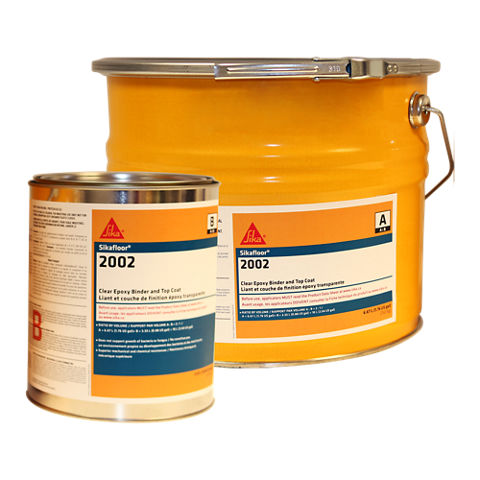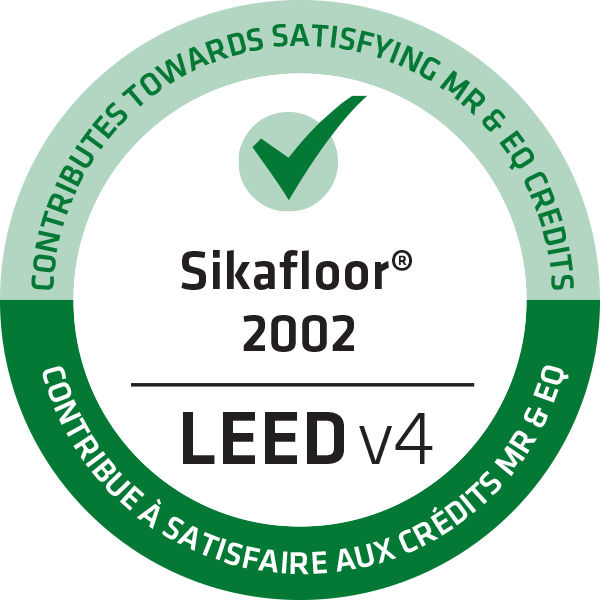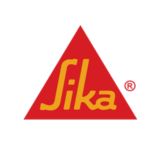
Sikafloor®-2002
CLEAR EPOXY RESIN BINDER AND TOP COAT
Sikafloor®-2002 is a two-component, high solids, low VOC, low odour, water clear, high gloss epoxy resin formulated to offer excellent aesthetic properties. Typically applied as the standard clear binder and top coat for multicoloured, decorative systems such as Sikafloor® Quartzite®, Sikafloor® DecoFlake® and Sikafloor® Metallic FX® Systems.
- Durable, impermeable and seamless surface
- Superior clear aesthetic finish
- Low VOC content and low odour
- Superior mechanical and chemical resistances
- Fade resistant
- Easily cleaned and maintained
- Does not support growth of bacteria or fungus
- Highest performance rating according to ASTM G21 resistance to fungi and ASTM D3273 resistance to mold growth (special order grade)

Usage
Sikafloor®-2002 is typically used in light to heavy traffic areas such as:- Hospitals, health care facilities
- Retail spaces (e.g. shopping malls, grocery stores)
- Manufacturing facilities and warehouses
- Commercial kitchens
- Laboratories, life sciences, pharmaceutical industries
- Leisure and culture (e.g. museums and stadiums)
- Offices and government buildings
Advantages
- Durable, impermeable and seamless surface
- Superior clear aesthetic finish
- Low VOC content and low odour
- Superior mechanical and chemical resistances
- Fade resistant
- Easily cleaned and maintained
- Does not support growth of bacteria or fungus
- Highest performance rating according to ASTM G21 resistance to fungi and ASTM D3273 resistance to mold growth (special order grade)
Packaging
| Component A: | 6.67 L (1.76 US gal.) | 20 L (5.28 US gal.) |
| Component B: | 3.33 L (0.88 US gal.) | 10 L (2.64 US gal.) |
| Components A+B: | 10 L (2.64 US gal.) | 30 L (7.92 US gal.) |
Colour
Clear
Product Details
ENVIRONMENTAL INFORMATION
Conformity with LEED® v4 MRc 2 (Option 1): Building Product Disclosure and Optimization – Environmental Product Declarations
Conformity with LEED® v4 EQc 2: Low-Emitting Materials
APPROVALS / CERTIFICATES
Meets the requirements of CFIA and USDA for use in food plants
Shelf Life
2 years in original, unopened packaging under proper storage conditions.
Storage Conditions
Store dry at temperatures between 5 °C to 32 °C (41 °F to 89 °F) and protect from freezing. If frozen, consult Sika Canada. Condition product at temperatures between 18 °C to 30 °C (65 °F to 86 °F) before use.
Viscosity
| ~292 cps (mixed) | (ASDTM D2196) |
Volatile organic compound (VOC) content
< 25 g/L
Shore D Hardness
| ~80 | (ASTM D2240) |
Abrasion Resistance
| ~76 mg loss | (ASTM D4060) Taber Abraser, Wheel CS 17/1000g (2.2 lb) / 1000 cycles |
Compressive Strength
| ~49.9 MPa (~7250 psi) | (ASTM C579) |
Tensile Strength
| ~39.5 MPa (~5728 psi) | (ASTM D638) |
Pull-Off Strength
| > 2.5 MPa (> 363 psi) (concrete failure) | (ASTM D7234) |
Gloss Level
| ~90 (60 degrees) | (ASTM D523) |
Coefficient of Friction
| ~0.32 Wet (smooth coating) ~0.92 Dry (smooth coating) | (ANSI A326.3) / BOT 3000e |
Water Absorption
| ~0.13 % (2 hours boiling) | (ASTM C413) |
Chemical Resistance
Consult Sika Canada
Application
Mixing Ratio
A:B =2:1 by volume
Product Temperature
Condition product between 18 °C to 24 °C (65 °F to 75 °F)
Ambient Air Temperature
Minimum 10 °C (50 °F) Maximum 30 °C (86 °F).
Relative Air Humidity
Maximum 85% (during application and curing)
Dew Point
Substrate must be at least 3 °C (5 °F) above the dew point to reduce the risk of condensation, which may lead to adhesion failure or “blushing” on the floor finish. Be aware that the substrate temperature may be lower than the ambient temperature.
Substrate Temperature
Minimum 10 °C (50 °F) Maximum 30 °C (86 °F).
Mixing and application attempted at material, ambient and/or substrate temperature conditions less than 18 °C (65 °F) will result in a decrease in product workability and slower cure rates.
Substrate Moisture Content
Moisture content of concrete substrate must be < 4 % (pbw – part by weight) as measured with a Tramex® CME/CMExpert type concrete moisture meter on mechanically-prepared surface according to this product data sheet (preparation to ICRI / CSP 3 - 4). If moisture content of concrete substrate exceeds 4 % (pbw – part by weight) as measured with Tramex® CME/CMExpert type concrete moisture meter, use Sikafloor®-1610 or Sikafloor®-81 EpoCem®CA or Sikafloor® 22NA or 24 NA PurCem®.
When relative humidity tests for concrete substrate are conducted per ASTM F2170 for project specific requirements, values must be ≤ 85 %. If values exceed 85 % according to ASTM F2170, use Sikafloor®-1610 or Sikafloor®-81 EpoCem®CA or Sikafloor® 22NA or 24 NA PurCem®. ASTM F2170 testing is not a substitute for measuring substrate moisture content with a Tramex® CME/CMExpert type concrete moisture meter as described above.
Do not apply while ambient and substrate temperatures are rising, as pinholes may occur. Ensure there is no vapour drive at the time of application. Refer to ASTM D4263, may be used for a visual indication of vapour drive.
Pot Life
| Material Temperature | Time |
| 10 °C (50 °F) | ~50 minutes |
| 20 °C (68 °F) | ~25 minutes |
| 30 °C (86 °F) | ~15 minutes |
Curing Time
| Substrate Temperature | Foot Traffic | Light Traffic | Full Cure |
| 10 °C (50 °F) | ~24 hours | ~3 days | ~10 days |
| 20 °C (68 °F) | ~8 hours | ~2 days | ~7 days |
| 30 °C (86 °F) | ~6 hours | ~36 hours | ~4 days |
Curing times will vary according to air and substrate temperatures and relative humidity.
Freshly applied material should be protected from dampness, condensation and water for at least 72 hours.
Mechanical, chemical and physical properties will be fully achieved at full cure.
Waiting Time / Overcoating
| Substrate Temperature | Minimum | Maximum |
| 10 °C (50 °F) | ~24 hours | ~36 hours |
| 20 °C (68 °F) | ~8 hours | ~24 hours |
| 30 °C (86 °F) | ~6 hours | ~24 hours |
Consumption
2 m2/L to 4 m2/L (80 ft2 / US gal. to 160 ft2 / US gal. ( 10- 20 mil w.f.t.)
Note: Actual coverage rates and material consumption will depend upon porosity and profile of substrates. Allowance must be also made for variation in film thickness or number of coats required to achieve complete coverage of surfaces. Test sections are recommended to establish correct coverage.
MIXING
Mix Ratio: A:B = 2:1 by volume
Do not hand mix Sikafloor® materials. Mechanically mix only.
Pre-stir Components A and B separately, making sure all solids, are evenly distributed and uniform consistencies are achieved within each individual Component. Empty Component B (Hardener) in the correct mix ratio into Component A (Resin) or empty Component A into a suitably sized and clean pail and add Component B in the correct ratio. Blend the combined components thoroughly at low speed (300 - 450 rpm) for at least three (3) minutes using a drill fitted with an Exomixer® or Jiffy type paddle suited to the dimensions of the mixing container. Keep the mixing paddle in the mix to minimize entrapped air. Take care not to introduce any air bubbles while mixing. Make sure the contents are completely mixed to avoid any weak or partially cured spots in the coating. During the mixing operation, scrape down the sides and
bottom of the container with a flat or straight edge trowel at least once to ensure complete mixing. When completely mixed, Sikafloor®-2002 should be uniform in colour and consistency.
Do not mix more material than can be applied within the working time limits (i.e. Pot Life) at the actual field temperature.
APPLICATION
Apply Sikafloor®-2002 using a non-marking squeegee or flexible steel trowel, followed by backrolling to provide a uniform texture and appearance. Over-rolling and or late back rolling may cause bubbling and leave roller marks. A second top coat application or a thicker initial application maybe required to achieve a specific texture or desired final appearance. Sika Canada strongly recommends that a test area be applied to confirm specific top coat selection and application rates required to produce the desired final appearance.
Note: If the Waiting/ Recoat time has passed (refer to Technical Data section) the previous coat must be lightly sanded, to remove all gloss; vacuum cleaning and solvent wiping will be necessary to remove all traces of dust. The surface should be a uniform dullness, with no gloss present after clean-up and before applying the next coat.
CLEAN UP
Clean all tools and equipment immediately with Sika® Epoxy Cleaner. Once cured, product can only be removed mechanically.
